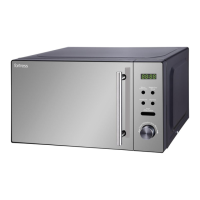9
Materials you can use in the microwave oven
Use small pieces of aluminium foil to cover thin parts of meat or poultry to prevent
overcooking. The foil should be at least 1 inch (2.5cm) away from oven walls.
Follow the manufacturer’s instructions. The bottom of browning dish must be at least
3/16 inch (5mm) above the turntable. Incorrect usage may cause the turntable break.
Microwave-safe only and follow the manufacturer's instructions. Do not use cracked
or chipped dishes.
Always remove lid. Applies only to warm the food. Most of the glass jars are not heat
resistant and may break.
Heat-resistant oven glassware only. Make sure there is no metallic trim. Do not use
cracked or chipped dishes.
Follow the manufacturer’s instructions. Do not close with metal tie. Make slits to allow
steam to escape.
Applies only for short time cooking or warming. Please stay and keep your eyes on
the container while cooking.
Use to cover food for reheating and absorbing oil. Applies only for short time cooking.
Please stay while cooking
Use as a cover on food to prevent splattering.
Microwave-safe only, please follow the manufacturer’s instructions.
Microwave-safe only. Use to cover food during cooking to retain moisture. Do not
allow plastic wrap to touch food.
Microwave-safe only (meat and candy thermometers).
Use as a cover to prevent food splattering and retain moisture.
Materials to be avoided in the microwave oven
May cause arcing. Transfer food into a microwave-safe dish.
Food carton with
metal handle
May cause arcing. Transfer food into a microwave-safe dish.
Metal or metal-
trimmed utensils
May cause arcing. Metal shields the food from microwave energy.
May cause arcing and could cause fire in the oven.
May cause fire in the oven.
Plastic foam may melt or contaminate the liquid inside when exposed to high
temperature.
Wood will dry out when used in the microwave oven and may split or crack.

